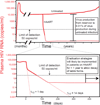Redefining the viral reservoirs that prevent HIV-1 eradication
- PMID: 22999944
- PMCID: PMC3963158
- DOI: 10.1016/j.immuni.2012.08.010
Redefining the viral reservoirs that prevent HIV-1 eradication
Abstract
This Perspective proposes definitions for key terms in the field of HIV-1 latency and eradication. In the context of eradication, a reservoir is a cell type that allows persistence of replication-competent HIV-1 on a timescale of years in patients on optimal antiretroviral therapy. Reservoirs act as a barrier to eradication in the patient population in which cure attempts will likely be made. Halting viral replication is essential to eradication, and definitions and criteria for assessing whether this goal has been achieved are proposed. The cell types that may serve as reservoirs for HIV-1 are discussed. Currently, only latently infected resting CD4(+) T cells fit the proposed definition of a reservoir, and more evidence is necessary to demonstrate that other cell types, including hematopoietic stem cells and macrophages, fit this definition. Further research is urgently required on potential reservoirs in the gut-associated lymphoid tissue and the central nervous system.
Copyright © 2012 Elsevier Inc. All rights reserved.
Figures


Similar articles
-
Reservoirs for HIV-1: mechanisms for viral persistence in the presence of antiviral immune responses and antiretroviral therapy.Annu Rev Immunol. 2000;18:665-708. doi: 10.1146/annurev.immunol.18.1.665. Annu Rev Immunol. 2000. PMID: 10837072 Review.
-
The challenge of viral reservoirs in HIV-1 infection.Annu Rev Med. 2002;53:557-93. doi: 10.1146/annurev.med.53.082901.104024. Annu Rev Med. 2002. PMID: 11818490 Review.
-
From reactivation of latent HIV-1 to elimination of the latent reservoir: the presence of multiple barriers to viral eradication.Bioessays. 2013 Jun;35(6):544-52. doi: 10.1002/bies.201200170. Epub 2013 Apr 24. Bioessays. 2013. PMID: 23613347 Free PMC article. Review.
-
LGIT In Vitro Latency Model in Primary and T Cell Lines to Test HIV-1 Reactivation Compounds.Methods Mol Biol. 2016;1354:255-64. doi: 10.1007/978-1-4939-3046-3_17. Methods Mol Biol. 2016. PMID: 26714717
-
Cellular reservoirs of HIV-1 and their role in viral persistence.Curr HIV Res. 2008 Sep;6(5):388-400. doi: 10.2174/157016208785861195. Curr HIV Res. 2008. PMID: 18855649 Free PMC article. Review.
Cited by
-
Restrictions to HIV-1 replication in resting CD4+ T lymphocytes.Cell Res. 2013 Jul;23(7):876-85. doi: 10.1038/cr.2013.74. Epub 2013 Jun 4. Cell Res. 2013. PMID: 23732522 Free PMC article. Review.
-
Gene-expression reversal of lncRNAs and associated mRNAs expression in active vs latent HIV infection.Sci Rep. 2016 Oct 19;6:34862. doi: 10.1038/srep34862. Sci Rep. 2016. PMID: 27756902 Free PMC article.
-
Microglial HIV-1 Expression: Role in HIV-1 Associated Neurocognitive Disorders.Viruses. 2021 May 17;13(5):924. doi: 10.3390/v13050924. Viruses. 2021. PMID: 34067600 Free PMC article.
-
Incomplete immune reconstitution and its predictors in people living with HIV in Wuhan, China.BMC Public Health. 2023 Sep 16;23(1):1808. doi: 10.1186/s12889-023-16738-w. BMC Public Health. 2023. PMID: 37716975 Free PMC article.
-
Cytotoxicity assessment, inflammatory properties, and cellular uptake of Neutraplex lipid-based nanoparticles in THP-1 monocyte-derived macrophages.Nanobiomedicine (Rij). 2017 Dec 21;4:1849543517746259. doi: 10.1177/1849543517746259. eCollection 2017 Jan-Dec. Nanobiomedicine (Rij). 2017. PMID: 29942393 Free PMC article.
References
-
- Alkhatib G, Combadiere C, Broder CC, Feng Y, Kennedy PE, Murphy PM, Berger EA. CC CKR5: a RANTES, MIP-1alpha, MIP-1beta receptor as a fusion cofactor for macrophage-tropic HIV-1. Science. 1996;272:1955–1958. - PubMed
-
- Anderson JA, Archin NM, Ince W, Parker D, Wiegand A, Coffin JM, Kuruc J, Eron J, Swanstrom R, Margolis DM. Clonal sequences recovered from plasma from patients with residual HIV-1 viremia and on intensified antiretroviral therapy are identical to replicating viral RNAs recovered from circulating resting CD4+ T cells. J. Virol. 2011;85:5220–5223. - PMC - PubMed
Publication types
MeSH terms
Substances
Grants and funding
LinkOut - more resources
Full Text Sources
Other Literature Sources
Medical
Research Materials

